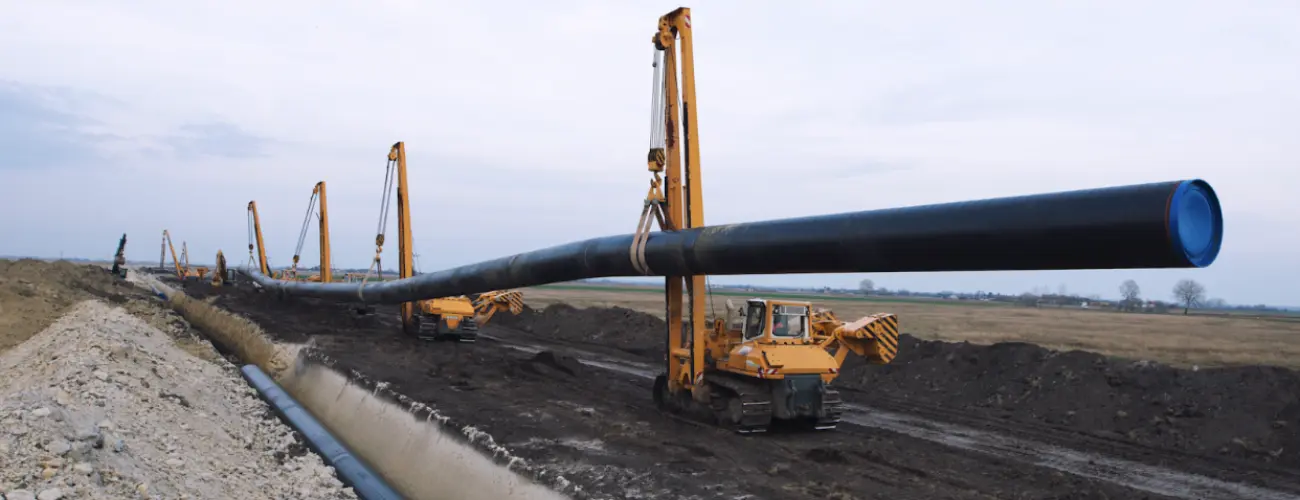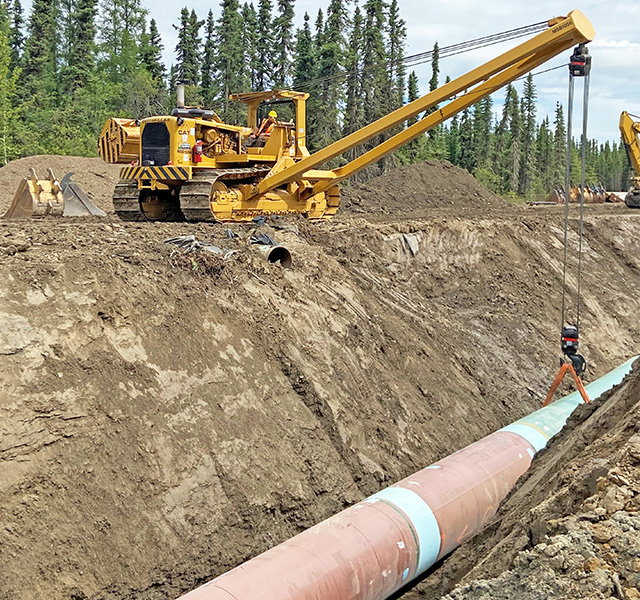What’s Needed for Professional Work With Creek Pipe Texas oilfield
The Significance of Pipeline Construction: Exploring the Solutions Supplied in the Sector
Pipeline construction is a crucial element of modern infrastructure. It assists in the transport of necessary resources like oil, gas, and water. The market includes different solutions, including planning, website prep work, and installation. Each stage requires precision and adherence to safety and security standards. As communities depend upon these systems for their resources, understanding the ins and outs of pipeline construction discloses its relevance and possible difficulties. What aspects affect the success of these projects?
Summary of Pipeline Construction Services
Pipeline construction solutions encompass a variety of specific tasks made to help with the setup of pipelines for delivering numerous compounds, including oil, gas, and water. These services typically consist of site preparation, excavation, installment of pipe sectors, and backfilling. Knowledgeable labor and sophisticated equipment are fundamental for assuring each phase is implemented with accuracy and safety.Safety protocols are extremely important, as these projects frequently entail working with dangerous materials and in tough settings. Quality control procedures establish that the pipes fulfill industry criteria and guidelines. In addition, the solutions may involve trenchless innovation, which reduces surface disruption.Environmental considerations play a significant duty in pipe construction, needing evaluations and mitigations to protect bordering ecosystems. On the whole, pipe construction services are vital for establishing the infrastructure essential for power and water circulation, supporting both economic development and social demands.
Planning and Design in Pipeline Projects
Efficient planning and design are vital parts of effective pipe jobs, ensuring that all aspects are carefully resolved prior to construction starts. This stage involves complete expediency research studies that evaluate the technical, economic, and ecological variables affecting the task. Engineers and developers work together to produce comprehensive plans that outline the pipe route, products, and construction methods, lining up with regulative requirements and sector standards.Advanced software program and modeling methods are typically employed to replicate various circumstances, enhancing the layout for effectiveness and safety and security. Environmental effect analyses are conducted to reduce possible injury to communities and areas, showing a dedication to lasting practices. Furthermore, stakeholder involvement is necessary, fostering interaction and dealing with problems from affected parties. Eventually, reliable preparation and design established the structure for a pipe job, minimizing dangers and making certain a streamlined construction process, ultimately adding to the total success of the operation.
Website Preparation and Excavation
Complete site prep work and excavation are essential steps in the pipeline construction process. This phase entails a comprehensive analysis of the land where the pipeline will be set up. Task teams carry out studies to determine dirt types, topography, and existing energy lines to assure a secure and effective excavation. Correct site prep work lessens environmental influence and assists in smoother construction operations.Excavation follows, where hefty machinery is used to get rid of soil and rock, developing a trench that satisfies the specified depth and width for the pipe. This process should adhere to security laws and environmental standards to avoid damages to surrounding ecosystems.Additionally, erosion control actions are carried out to support the site during and after excavation. Efficient site preparation and excavation add greatly to the total success of pipe jobs, laying a solid structure for the succeeding stages of construction.
Pipeline Installation Strategies
Pipeline installation methods are vital for the successful application of infrastructure tasks. Two noticeable methods consist of trenchless technology, which reduces surface area disruption, and the open-cut excavation procedure, recognized for its uncomplicated technique. Each technique uses distinctive advantages and factors to consider depending upon project demands and ecological elements.
Trenchless Innovation Approaches
While conventional techniques of pipe installation commonly involve substantial excavation, trenchless modern technology methods provide an extra reliable and eco-friendly alternative. These ingenious methods, such as straight directional boring and pipeline bursting, reduce surface area disruption by permitting the installation of pipelines without considerable digging. This not only decreases the ecological influence yet also substantially reduces labor and remediation expenses. Trenchless techniques facilitate the setup of pipes in urban areas where conventional excavation would certainly be impractical or harmful to existing framework. In addition, these techniques can fit various dirt kinds and conditions, making them flexible solutions for pipe construction. Eventually, trenchless technology represents a significant innovation in the pipeline next industry, promoting sustainability and operational effectiveness.

Open-Cut Excavation Refine
Open-cut excavation stays an essential technique in pipe setup, characterized by the straight excavation of a trench to lay pipes. This method entails getting rid of dirt and other products to create a trench of enough depth and size, allowing for the positioning of pipes at the needed grade. Open-cut excavation is commonly chosen for its cost-effectiveness and simpleness, especially in locations with stable soil conditions. Nevertheless, it can interrupt surface area activities and requires mindful preparation to handle website traffic and ecological effects. Precaution have to be carried out to shield workers and close-by framework during the excavation process. On the whole, while open-cut excavation might not be suitable for all terrains, it continues to be a commonly made use of method in pipeline construction.
Checking and Quality Control
Testing and quality control are critical elements in pipeline construction, ensuring that installments meet established safety and security requirements and efficiency requirements. Various inspection strategies and methods are employed to analyze worldly quality and adherence to regulative compliance. This methodical method assists determine prospective problems prior to they rise, safeguarding the stability of the pipe system.

Inspection Techniques and Methods
Evaluation methods and techniques are necessary components in making sure the honesty and safety of pipe construction. Numerous strategies, consisting of visual inspections, ultrasonic screening, and radiographic exams, are utilized to find flaws and confirm quality. Aesthetic examinations enable the recognition of surface area anomalies, while ultrasonic testing utilizes sound waves to examine wall thickness and situate imperfections inside. Radiographic exams involve X-rays or gamma rays to generate pictures of the pipe's framework, disclosing concealed concerns. Additionally, stress testing is performed to assess the pipe's integrity under functional conditions. These techniques collectively contribute to a complete understanding of the pipeline's problem, making it possible for timely upkeep choices and guaranteeing conformity with industry criteria. Effective examination is vital for protecting against failures and advertising lasting operational security.
Safety And Security Criteria Compliance
Making certain compliance with safety requirements is paramount in pipe construction, as it straight influences the job's overall top quality and dependability. Adhering to recognized laws and click here for info guidelines assurances that construction practices mitigate dangers related to pipe setup and operation. Creek Pipe trenching services. Strenuous screening methods, including non-destructive screening and stress analyses, are crucial in validating that pipelines can withstand the operational stresses they will certainly run into. Quality control actions are also vital, as they establish a framework for consistent monitoring and evaluation throughout the construction procedure. By focusing on security requirements compliance, companies not just shield employees and the atmosphere however likewise improve the stability of the pipeline, inevitably leading to long-term functional success and public trust fund in the framework
Material Top Quality Analysis
Material quality assessment plays a considerable function in the general stability of pipe construction. This procedure includes strenuous testing and quality control procedures to ensure that materials fulfill industry standards and specifications. Numerous examinations, including tensile stamina, corrosion resistance, and weld honesty analyses, are carried out to identify any kind of prospective weaknesses. A complete examination not only guarantees the efficiency of the pipeline but additionally boosts safety and longevity over its life-span. Furthermore, applying quality assurance protocols aids alleviate dangers linked with material failings, which can bring about expensive repairs and ecological hazards. By focusing on material high quality evaluation, business can assure compliance with governing requirements while promoting self-confidence among stakeholders in the dependability of their pipeline systems.
Repair And Maintenance Solutions
Upkeep and repair services play an important function in the long life and efficiency of pipeline systems. These solutions incorporate regular inspections, fixing, and restorative activities to address damage, leaks, and other concerns that might emerge with time. Competent specialists utilize advanced technologies such as ultrasonic screening and clever pigging to check pipe stability, making certain that any kind of prospective issues are identified early.Additionally, maintenance programs typically include scheduled preventive measures made to boost system integrity and minimize the probability of unforeseen failures. Repair services may include the replacement of damaged areas, securing leaks, or using trenchless technology for marginal disturbance.
Environmental Compliance and Precaution
Pipeline systems not only call for recurring maintenance and repair work to operate successfully however likewise should abide by rigid environmental compliance and safety actions. These regulations are important for reducing eco-friendly influence and making sure public security. Companies in the pipeline construction sector apply detailed environmental analyses before project initiation, recognizing prospective threats to wildlife and ecosystems.Furthermore, adherence to safety procedures safeguards workers and surrounding areas. This consists of regular training on emergency situation reaction and spill avoidance techniques.To maintain conformity, markets make use of keeping track of technologies to identify leaks and various other anomalies in real-time. Ecological management strategies are often established to lay out steps for addressing unanticipated issues during construction.Ultimately, rigorous adherence to ecological conformity and safety and security actions not only satisfies lawful commitments but additionally cultivates lasting practices within the market, advertising a balance between infrastructure growth and ecological stewardship.
Often Asked Concerns
What Profession Opportunities Are Readily Available in Pipeline Construction?
Occupation possibilities in pipeline construction include functions such as project managers, engineers, welders, and security assessors. These placements require diverse abilities, offering pathways for growth in a crucial field of facilities growth and energy circulation.

How Do Pipeline Projects Impact Local Communities?
Pipeline jobs greatly affect regional communities by influencing financial growth, supplying job chances, and boosting facilities. They may likewise increase problems about environmental results, land usage, and potential interruptions to area communication and natural environments.
What Modern technology Is Used in Modern Pipeline Construction?
Modern pipeline construction makes use of advanced technologies such as GIS for mapping, drones for airborne studies, and automated welding systems to enhance efficiency, safety, and precision, ultimately facilitating the effective transportation of sources across numerous terrains. Creek Pipe Midland.
How Are Pipeline Construction Expenses Estimated?
Pipeline construction costs are estimated via detailed analyses of products, labor, tools, and regulative demands. Aspects like terrain, project size, and ecological factors to consider additionally substantially affect the total budget plan and financial planning for construction.
What Are the Biggest Obstacles in Pipeline Construction Projects?
The largest difficulties in pipeline construction projects consist of regulative compliance, environmental problems, logistical concerns, protecting funding, and taking care of labor scarcities. Each element can significantly impact timelines and budgets, complicating the general execution of click the project.